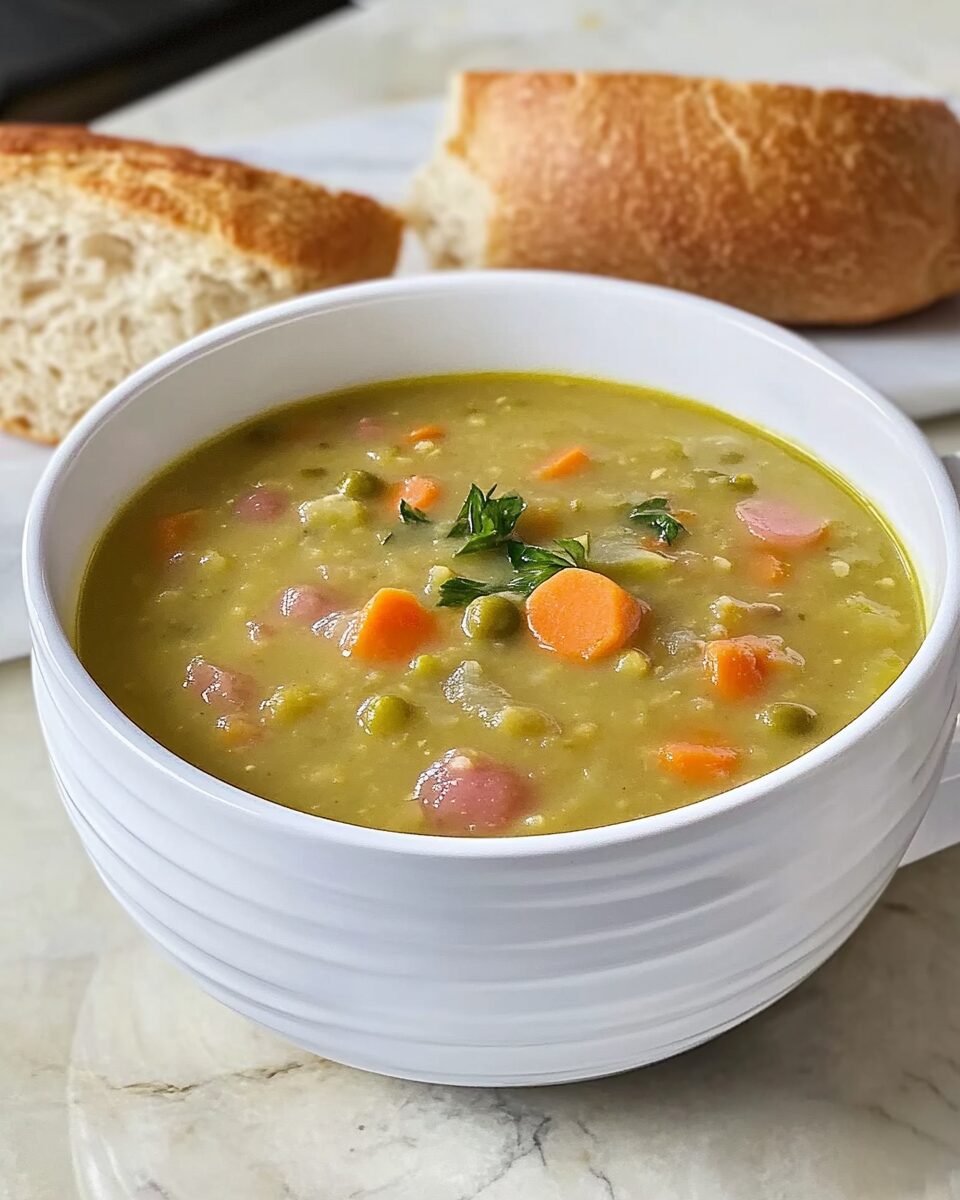Split Pea Soup is a hearty and comforting dish, perfect for chilly days. Made with dried split peas and a variety of vegetables, it’s both nutritious and satisfying. This soup is rich in protein and fiber, making it a great option for a filling meal. Beyond its delightful taste, split pea soup is lauded for its health advantages, being a substantial source of plant-based protein, dietary fiber, and essential vitamins. Its simplicity in preparation and the availability of ingredients have cemented its place in both historical and modern culinary practices.
Full Recipe:
INGREDIENTS
- 2 ¼ cups dried split peas
- 2 quarts cold water
- 1 ½ pounds ham bone
- 2 onions, thinly sliced
- ½ teaspoon salt
- ¼ teaspoon ground black pepper
- 1 pinch dried marjoram
- 3 stalks celery, chopped
- 3 carrots, chopped
- 1 potato, diced
DIRECTIONS
- In a large pot, combine the split peas, water, and ham bone. Bring to a boil, then reduce heat and simmer for about 1 hour, stirring occasionally.
- Remove the ham bone and set it aside to cool.
- Add the onions, salt, pepper, marjoram, celery, carrots, and potato to the pot. Continue to simmer until the vegetables are tender, approximately 30 minutes.
- While the vegetables are cooking, remove any meat from the ham bone, chop it, and return it to the pot. Discard the bone.
- Once the soup reaches your desired consistency, adjust the seasoning as needed and serve hot.
NUTRITIONAL FACTS (PER SERVING)
- Calories: 223
- Total Fat: 3.6g
- Saturated Fat: 1.1g
- Cholesterol: 17mg
- Sodium: 871mg
- Total Carbohydrates: 35.5g
- Dietary Fiber: 13.1g
- Total Sugars: 6.3g
- Protein: 15.6g
HISTORICAL BACKGROUND
The origins of split pea soup can be traced back to ancient civilizations. Peas have been cultivated for thousands of years, and evidence suggests that both the Greeks and Romans consumed variations of pea soup as early as 500 BC. During the Middle Ages, dried peas became a staple ingredient across Europe due to their long shelf life and affordability. By the 19th century, split pea soup became a common dish in many countries, particularly in Northern and Central Europe. The Dutch, for example, are known for their version called “erwtensoep,” which is a thick pea soup traditionally served in winter. In France, a similar version called “soupe aux pois” was often made with yellow split peas and ham. In North America, early settlers embraced the dish for its ability to provide sustenance with minimal ingredients.
CULTURAL SIGNIFICANCE
Split pea soup remains an important dish in many cultures worldwide. Each region has developed its own variations, incorporating local ingredients and seasonings to enhance its flavor.
- In the United States and Canada, split pea soup is often associated with comfort food and is commonly prepared using ham hocks or smoked meats to enhance its richness.
- In the Netherlands, it is traditionally served as a thick stew with rye bread, making it a staple during cold winter months.
- In Germany, pea soup is commonly paired with sausage and served with bread for a hearty meal.
- In Scandinavian countries, it is often flavored with mustard and accompanied by pancakes as part of a traditional meal.
This soup has remained popular not only for its taste but also for its ability to be easily adapted to different cooking styles and dietary needs.
NUTRITIONAL BENEFITS
Split pea soup is not just a delicious meal—it is also packed with numerous health benefits. Some of its key nutritional highlights include:
- High in Protein – Split peas are a great source of plant-based protein, making this soup an excellent option for vegetarians and those looking to reduce meat consumption.
- Rich in Fiber – The high fiber content promotes good digestion, helps maintain stable blood sugar levels, and keeps you feeling full longer.
- Low in Fat – Since split peas are naturally low in fat, this soup is a heart-healthy choice when prepared with minimal added oils or fats.
- Packed with Vitamins and Minerals – Split peas provide essential nutrients like iron, potassium, magnesium, and vitamins A, B, and K, all of which contribute to overall health.
- Supports Heart Health – The fiber and potassium content in split peas help lower cholesterol and regulate blood pressure, reducing the risk of heart disease.
- Aids in Weight Management – Due to its high protein and fiber content, split pea soup is a satisfying and low-calorie meal that can help with maintaining a healthy weight.
HEALTH CONSIDERATIONS
For those following specific dietary plans, split pea soup can be modified to meet various nutritional needs:
- Vegetarian & Vegan – The soup can be made completely plant-based by using vegetable broth instead of meat-based stock and omitting any added ham or bacon.
- Low-Sodium – Since many traditional recipes use ham or processed meats, reducing the salt and using fresh herbs can help lower sodium intake.
- Gluten-Free – Most traditional split pea soup recipes are naturally gluten-free, but it is always important to check ingredients such as store-bought broth or seasonings.
CULINARY VERSATILITY
One of the best things about split pea soup is how easily it can be customized. By making small adjustments, you can create a version that suits your preferences while keeping the essence of this classic dish intact.
- For a Smoky Flavor: Adding smoked paprika or chipotle powder can bring an extra depth of flavor.
- For Extra Creaminess: Blending a portion of the soup or adding a splash of coconut milk can create a smooth and rich texture.
- For Added Freshness: Garnishing with fresh herbs like parsley or thyme enhances the overall taste.
- For a Spicy Kick: A dash of cayenne pepper or chopped chili peppers can give the soup a bit of heat.
Whether you enjoy it as a rustic, chunky soup or a smooth, creamy dish, split pea soup is adaptable to various tastes and preferences.
TIPS FOR MAKING THE BEST SPLIT PEA SOUP
To achieve the perfect consistency and flavor, consider the following tips when making split pea soup:
- Rinse the Split Peas Thoroughly – This removes any dust or debris and ensures a cleaner, fresher taste.
- Use a Ham Bone for Extra Flavor – If you eat meat, simmering the soup with a ham bone infuses it with deep, savory flavors.
- Simmer Slowly for Maximum Taste – Cooking the soup over low heat for an extended period allows the flavors to meld and develop fully.
- Stir Occasionally – Since split peas can stick to the bottom of the pot, stirring occasionally prevents burning and ensures even cooking.
- Adjust Thickness as Needed – If the soup becomes too thick, adding a little extra broth or water helps achieve the desired consistency.
STORAGE AND REHEATING
Split pea soup stores exceptionally well, making it a great option for meal prep:
- Refrigeration – Store in an airtight container in the refrigerator for up to 4 days. Reheat on the stovetop over medium heat, adding a little water if the soup has thickened.
- Freezing – Split pea soup freezes well for up to 3 months. To freeze, allow the soup to cool completely before transferring it to a freezer-safe container. Thaw in the refrigerator overnight before reheating.
- Reheating Tips – Since the soup thickens as it sits, adding a bit of broth or water while reheating helps restore its original texture.
WHY YOU SHOULD TRY SPLIT PEA SOUP
There are plenty of reasons to make split pea soup a regular part of your diet:
- It’s Budget-Friendly – Made with affordable ingredients like dried split peas, vegetables, and basic seasonings, this soup is a cost-effective meal.
- It’s Easy to Prepare – Even beginners in the kitchen can master this soup with minimal effort.
- It’s Ideal for Meal Prep – Since it stores well, you can make a large batch and enjoy it throughout the week.
- It’s Perfect for All Seasons – While it is often associated with winter, split pea soup is a satisfying dish year-round.
CONCLUSION
Split pea soup is a delicious, nutritious, and versatile dish that has stood the test of time. Its rich history, numerous health benefits, and ability to be customized make it a fantastic option for anyone looking for a comforting and wholesome meal. Whether you prefer a traditional ham-based recipe or a plant-based alternative, this soup delivers both flavor and nourishment.






